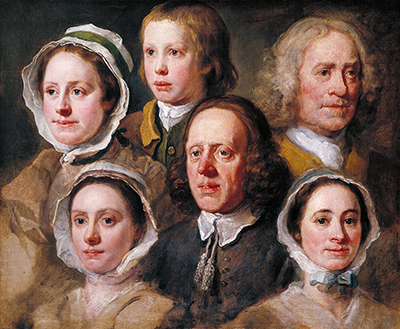This oil-on-canvas portrait of Hogarth's Servants is unusual in regarding its subjects affectionately as unique individuals - which of course they were, but in Hogarth's time, servants were not often afforded this dignity.
Painted in the early 1750s, it was not commissioned, but was probably intended to prove the artist's skill in portraiture and characterisation, hanging as it did on view in his studio. The servants were not painted together, but as suggested by the picture's full title of Heads of Six of Hogarth's Servants, the portraits have been arranged later in a composition that showcases the qualities of each person. Light comes from the upper left-hand corner of the frame. Whereas the women all seem to be around the same age, the three men cover a range from boyhood to old age. The faces are sympathetic and natural, with Hogarth's servants all in their working clothes. They hold their heads high with confidence and candour, and are obviously held in affection by their master.
The womens' features are strong and proud, while the two men show the wisdom of maturity. Only the boy displays signs of a lack of confidence to be expected of a young person in a new environment, as he enters the adult world of work available to his class. Nevertheless, he retains hints of mischief in his eyes, as a last vestige of youth. The identities of the sitters in Hogarth's Servants are not certain - it has been suggested that the female staff members are housemaids and housekeeper, with the males being a valet, page and coachman. The older man could be Hogarth's elderly servant Ben Ives, with one of the others possibly being called Samuel. One of the women may be Mrs Chappel, who was in the family home at Chiswick, and another could be Hogarth's cousin's wife Mary Lewis, who inherited this painting later on.
Hogarth was influenced by Italian and French paintings and engravings, and as well as using oils, he was an engraver and printmaker who produced cartoons with a moral message, making him also a satirist and social critic. He is best known for his pictorial series such as A Rake's Progress, depicting London life in the eighteenth century. His upbringing in a poor lower middle class family, with a father who was once imprisoned for debt, no doubt informed the artist's opinions all his life. This respect is evident in his treatment of the subjects of Heads of Six of Hogarth's Servants, now part of the Tate's collection in London. William Hogarth has influenced caricaturists and social commentators ever since, and today, his honesty and empathy continue to inspire artists, composers, writers and film-makers.




